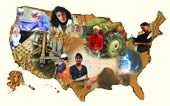Appendix A • Survey and Surveillance Program Descriptions
Adult Blood Lead Epidemiology and Surveillance (ABLES) Program
Since 1987, the National Institute for Occupational Safety and Health (NIOSH) of the Centers for Disease Control and Prevention (CDC) has sponsored the ABLES program to track laboratory-reported blood lead levels (BLLs) in adults. The public health goal of the ABLES program, as stated in Healthy People 2010, is to reduce the number of adults with work-related BLLs equal to or greater than 25 micrograms per deciliter (µg/dL) [DHHS 2000]. For the States that report data to ABLES, the primary sources of BLL reports are public and private laboratories; physician reporting may supplement laboratory reporting. ABLES requires the laboratory reporting of BLL results, both occupational and nonoccupational. These laboratory reports include basic demographic information, including personal identifiers, to differentiate between incidence and prevalence cases and to account for multiple reports for the same person. In coordination with the ABLES program, the Council of State and Territorial Epidemiologists (CSTE) has adopted a surveillance case definition for adult BLLs to be reported. The definition provides that “(an) adult blood lead level that should be maintained under surveillance is defined as an adult (16 or older) with a venous (or comparable) blood lead level equal to or greater than 25 micrograms per deciliter (µg/dL) of whole blood” [Stanbury and Roscoe 1999].
The ABLES program aims to accomplish the Healthy People 2010 objective by building capacity at the State level to initiate or improve surveillance programs that can accurately measure trends in adult BLLs and intervene to prevent further exposures to lead. Nationwide data and findings from the ABLES program are periodically published in the CDC’s Morbidity and Mortality Weekly Report (MMWR) [CDC 1999]. The NIOSH ABLES program has published 24 reports in the MMWR, which may be retrieved at www.cdc.gov/mmwr/mmwrsrch.htm by searching for “ables AND blood lead" for the years 1989 to the present year.
For further information, contact
Surveillance Branch
Division of Surveillance, Hazard Evaluations, and Field Studies
National Institute for Occupational Safety and Health
4676 Columbia Parkway, MS–R21
Cincinnati, OH 45226
Telephone: 513–841–4424
www.cdc.gov/niosh/ables.html

